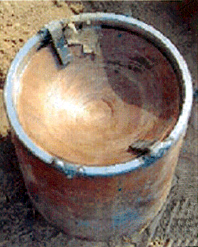Explosively formed penetrator
An explosively formed penetrator (EFP), - also known as an explosivley formed projectile, a self forging warhead, a self forging fragment, or a shaped charge - is a specialized weapon designed to penetrate armour effectively.
Difference from conventional shaped charges
A conventional shaped charge has a generally conical metal liner that projects a hypervelocity jet of metal able to penetrate to great depths of even armour steel; however, in travel the jet breaks up into particles that drift out of alignment, greatly diminishing its effectiveness at a distance.
An EFP, on the other hand, has a liner in the shape of a shallow dish. On detonating the explosive, the liner is transformed into a projected compact body of metal generally remains intact and is therefore able to penetrate armour at long range. It can easily punch through the protection of light- to medium-armoured vehicles, to deliver a wide spray of fragments of liner material and vehicle armour backspall into the vehicle's interior, injuring its crew and damaging other systems. EFPs have been adopted as warheads in several weapon systems, including the TOW-2B anti-tank missile and the SADARM submunition.
Use in improvised explosive devices

EFPs have been used in Improvised Explosive Devices against armoured cars, for example in the 1989 assassination of the German banker Alfred Herrhausen (attributed to the Red Army Faction), and by the Hezbollah in the 2006 Israel-Lebanon conflict. A recent development is their widespread introduction in IEDs by insurgents in Iraq.
The charges are generally cylindrical, fabricated from commonly available water or oil pipe, with the forward end closed by a concave copper or steel disk-shaped liner to create a shaped charge. Explosive is loaded behind the metal liner to fill the pipe. Upon detonation, the explosive projects the liner to form a projectile at a velocity well over 1 km/s, depending on the design and type of explosive used.
Often mounted on crash barriers at window level, they are placed along roadsides at choke points where vehicles must slow down, such as intersections and junctions. This gives the operator time to judge the moment to fire, when the vehicle is moving more slowly. The intent is often to penetrate the vehicle crew compartment.
Detonation is controlled by cable, radio control (RC), or remote arming with passive IR (PIR) trigger. EFPs can be deployed singly, in pairs, or in arrays, but the common practice is singly as it reduces the likelihood of wasting a number of valuable weapons upon discovery.
References
- Fundamentals of Shaped Charges, W.P. Walters, J.A. Zukas, John Wiley & Sons Inc., June 1989, ISBN 0-471-62172-2
- Tactical Missile Warheads, Joseph Carleone (ed.), Progress in Astronautics and Aeronautics Series (V-155), Published by AIAA, 1993, ISBN 1-56347-067-5
See also
External links
- U.S. Air Force description of an EFP
- Military.com article on the evolution of hand held anti-tank technology
- DoD Directive 2000.19E, "Joint Improvised Explosive Device Defeat Organization (JIEDDO)", February 14, 2006
- The Telegraph, "The precision-made mine that has killed 17 British troops", June 25, 2006
- Salon, "Surge of danger for US troops", January 22, 2007
